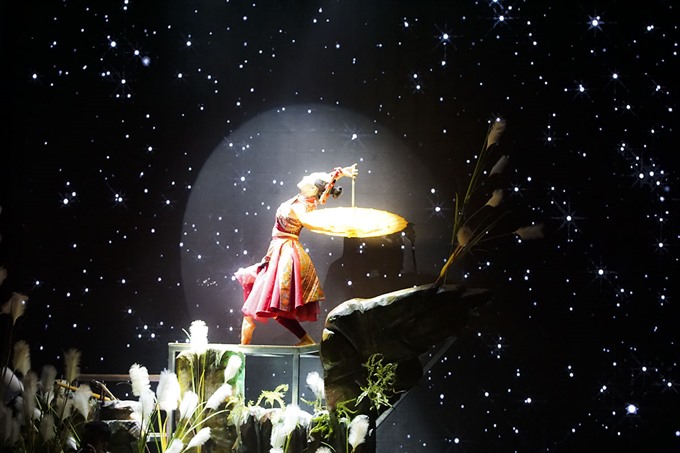The harmonious sound of bamboo pan flute lure Mông young men and women to come to a spring market where they perform singing, dancing and colourful costumes. There, they also find their love.

Artistic message: The play also raises a voice against out-dated customs, including marriage by kidnapping and drug use.
Unique culture lifestyle of the ethnic Mông people would open an art performance which made a debut on October 11 in Hà Nội, just after this publication went to print.
Entitled "Mỵ", the performance features a rich blend of the Mông culture with traditional musical instruments played live on stage and daily utensils used as props for the screen production.
In Mông costumes, 200 actors and actresses perform a combination of installation arts, dancing, singing and circus.
The show promised to leave a deep impression on the Hà Nội audience as well as international tourists.
Inspired by Vợ Chồng A Phủ (A Phủ and His Wife), a short story written by Tô Hoài in 1953, the artists from the Việt Bắc Theatre for Traditional Folk Music and Dance reinterpreted the literary work into the language of the performing arts.
It’s the story of a beautiful ethnic Mông girl named Mỵ. Due to the custom of marriage by "kidnapping", she was forced to marry a man she doesn’t love.
"Kidnapping" marriage is portrayed as the cause of suffering of Mông women and parents at the hands of cruel, greedy and exploitative landlords and rulers.
The 12-act play is choreographed, scripted and directed by Nguyễn Tuyết Minh.
Instead of reproducing the life tragedy of Mỵ, the main character of the short story, as in the original, the stage version highlights the unique culture of the Mông through depictions of a romantic love market, folk games and the people’s daily activities, such as the making of maize wine, weaving and fabric dyeing.
The play also raises a voice against outdated customs, including "kidnapping" marriage and drug use.
Minh decided to feature live music for the stage instead of electronic music. Minh and her team spent days searching for Mông master artists and convinced them to provide instructions for the troupe members on how to play the traditional Mông musical instruments.
It took the troupe five months to practise and play the instruments well in harmony.
Four songs composed exclusively for the show by Lê Minh Sơn, Mạnh Tiến, Minh Đức and Nông Xuân Ái would be performed in a capella style, which were expected to leave an emotional impression on the theatre goers.
In addition, Mỵ is expected to be enjoyed by the audience and art critics thanks to the costume designs, with designer Hoàng Tùng featuring the arts of brocade making and the decorative patterns of the Mông.

Honouring heritage: The show highlights the unique culture of the Mông ethnic community. — Photo courtesy of the organiser
A cultural product for tourists
The show was made under the orders of the Ministry of Culture, Sports and Tourism with the aim of honouring the traditional culture of people in the northern mountainous region. It received financial support from some businesses at a total investment of VNĐ3 billion (US$130,000).
The 90-minute performance won two gold and three silver medals at the National Song and Dance Festival held in July. It was named the Most Impressive Programme, and art director Minh was named Best Choreographer of the festival.
After the festival, the artists wanted to bring it closer to audiences so they designed it as a cultural product for tourists visiting the Hà Nội Opera House.
The play has been adjusted into a 30-minute performance to make it fit the tour’s schedule. Accordingly, the singing has been reduced while dancing and folk music are spotlighted on the stage. English subtitles and plot points were also added.
“It’s interesting to have the show at the end of the tour to the Hà Nội Opera House,” said Minh.
Nguyễn Thành Nam, director of Nam Hưng Media Company, producer of the show, said "Mỵ" was the beginning of a series of Nam An Shows – art performances at the Hà Nội Opera House. He began planning for the shows two years ago.
“We will produce different performances featuring the traditional culture of different regions and ethnic groups nationwide through the language of contemporary arts,” he said.
After a debut on October 11 at the Hà Nội Opera House, the organiser plans to present 10 shows until the end of the year. Information and tickets are available at www.namanshow.com. — VNS